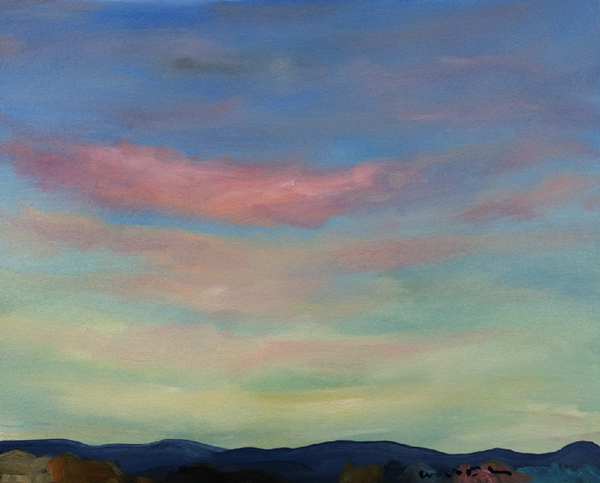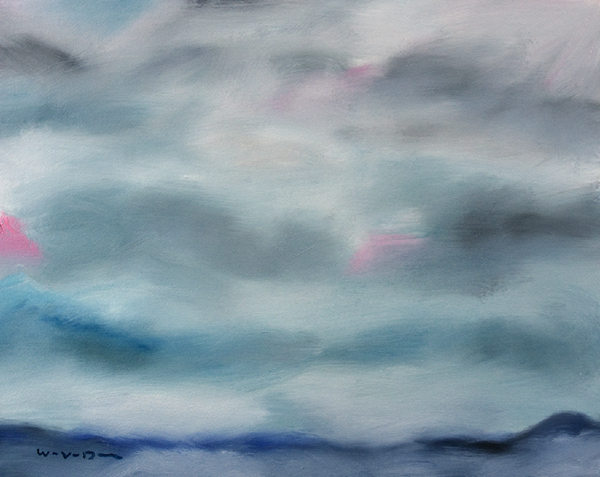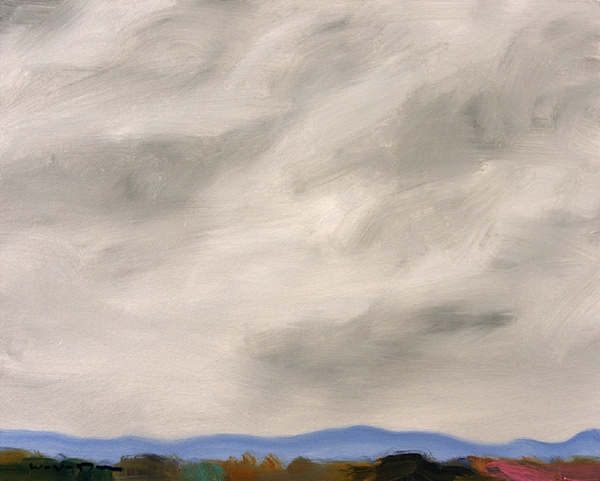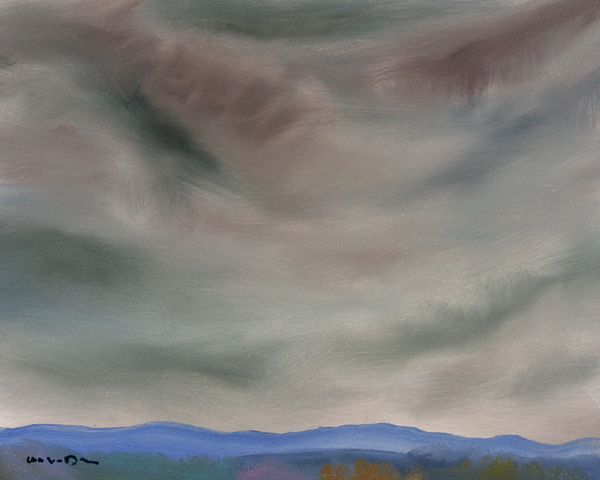 Tuesday, November 17, 2009 at 07:14PM | by
Tuesday, November 17, 2009 at 07:14PM | by  BVD | in
BVD | in  Print/Cards Available,
Print/Cards Available,  Sunset Paintings | tagged
Sunset Paintings | tagged  Blue Ridge | | Comments Off
Blue Ridge | | Comments Off  Tuesday, November 17, 2009 at 07:14PM | by
Tuesday, November 17, 2009 at 07:14PM | by  BVD | in
BVD | in  Print/Cards Available,
Print/Cards Available,  Sunset Paintings | tagged
Sunset Paintings | tagged  Blue Ridge |
Blue Ridge |  Share Article | Comments Off
Share Article | Comments Off  William Theodore Van Doren. Stony Point, Albemarle County, Va. Oil on paper, 16 x 20.
William Theodore Van Doren. Stony Point, Albemarle County, Va. Oil on paper, 16 x 20.
Having been for a long time – too long a time, about eight years, from age 16 to 24 – a devotee of Ayn Rand and Objectivism, I don’t think I can stand to read the two recent Rand biographies, even though they’re the first to be done by people outside her camp. About the most I could manage was to read the lengthy review by Thomas Mallon in The New Yorker. Mallon makes a number of excellent observations, including various ways Rand manifested behavior that was exactly the opposite of the qualities she espoused – for example, prizing meek compliance by others with her every view while publicly claiming to worship the character trait of independent thinking.
There’s only one contribution I’ve ever wanted to make to the discussion of the life and work of Ayn Rand, and Mallon comes very close to taking care of it in his review, when he writes:
Rand may be, in an aesthetic sense, the most totalitarian novelist ever to have sat down at a desk.
Along those lines, what I’ve wanted to say – hey, I’ve been saving this up since 1972, ever since I began to notice that the thought progressions in The Ayn Rand Letter were, beneath their confidently hard-waxed surface, positively deranged – is that Rand ultimately relied on the use of literally compelling rhetoric rather than on the actual content of ideas. In other words, her chief weapon – and it was exactly that – was a device she condemned, and which she called “the argument from intimidation.” You can find it defined in a really scary website assembled by her disciples, the Ayn Rand Lexicon.
Rand made her living rendering rhetoric that would be so forceful, so powerfully, even sometimes beautifully symmetrical, so ruthlessly logical in its sound and its appearance, once you allowed yourself to step inside its force field, you could be overwhelmed. There would appear to be no escape. But it only looked logical. It sounded rational. It was in fact a fantastic structure based on a profound desire to make the world conform to what she wished it to be in her mind, which became the will to intimidate.
O.K., I feel better now.
 BVD
BVD
For anyone interested in the American right wing’s attempts to claim Ayn Rand as part of its ideological heritage, I strongly recommend a recent post on DailyKos, “The Ayn Rand Myth” by Laurence Shatkin.
 Sunday, November 15, 2009 at 06:46PM | by
Sunday, November 15, 2009 at 06:46PM | by  BVD | in
BVD | in  Commentary,
Commentary,  Sunset Paintings | tagged
Sunset Paintings | tagged  Ayn Rand,
Ayn Rand,  Ayn Rand Lexicon,
Ayn Rand Lexicon,  Blue Ridge,
Blue Ridge,  Objectivism,
Objectivism,  The Ayn Rand Letter,
The Ayn Rand Letter,  The New Yorker,
The New Yorker,  Thomas Mallon |
Thomas Mallon |  Share Article | Comments Off
Share Article | Comments Off  William Theodore Van Doren. Stony Point, Albemarle County, Va. Oil on paper, 16 x 20.
William Theodore Van Doren. Stony Point, Albemarle County, Va. Oil on paper, 16 x 20.
Even though it hasn’t really stopped raining – thanks to the monster nor’easter off the coast – I’m ready with my little aside to The Men Who Stare At Goats.
I’ve learned that some wild ideas I published an article on 28 years ago have come full circle – or maybe it would be more accurate to say, have done an acrobatic loop – and are the basis for the film. Since the ideas were new when I ran the article, and are now being satirized by Hollywood, it may be safe to conclude that they’ve gone through some sort of complete life cycle.
The story was by L.A.-based writer Bill Crandall. This was my intro to his piece, in the August 7, 1981, issue of my poster-sized publication The Wall Paper:
The Los Angeles Reader recently ran a feature story on Army Lt. Col. Jim Channon and his “First Earth Battalion.” The article explains Channon’s concept of a special ‘holistic’ ‘new age’ Army unit of ‘warrior monks’ that would conquer with deadly force if necessary but might also use ‘will’, ‘spirit’ or ‘love’. Although the Battalion does not yet exist as an operational unit, its content and objectives are being developed with the support of the Army command.
As Crandall then explained:
Channon takes himself for the focus of a dialectical synergy between the Pentagon and the New Age folks. He wants to send his soldiers out with “ginseng, amphetamines, megavitamins, herbs, and night-vision [all-natural] foods.” ... These sweeties are also to be armed to the teeth and trained in oriental martial arts. Military lunacy is nothing new, but this man wants to freak out with style, he wants his killing with spice – ritual, he says, after the manner of warpaint and feathers. Tanks blaring Black Sabbath or “something like the sound of a 110-piece black high school band really jiving ... crescendos that go higher and higher.”
When I ran the story, I pretty much decided to take Bill’s word, and the relatively sober reputation of the L.A. Reader, as reason to accept that this concept was actually being entertained by our military. But I did have my doubts. Now I find out, in 2009, it was all true all along – all this, and more. Practitioners of these, how to say, enlightened black arts, were and in some cases still are, associated with our armed forces.
If you go to the website for The Men Who Stare At Goats, to the highly informative and entertaining page by the author of the original book, you learn that there was only one man who actually stared at goats in the First Earth Battalion:
... the goat starer ... says he managed to drop one goat once, although there is no way of verifying this. The goat starer runs a dance studio in Ohio now. When I approached him for an interview I asked him if he was still practicing the technique and he said yes, and only last week he killed his hamster just by staring at it.
Actually, if I were that guy’s hamster, I might have died of a heart attack just thinking about my owner.
As funny as much of the material sounds – an Army general kept expecting to be able to walk through walls because, after all, they’re composed of tiny atoms whirling in space – the endeavor eventually made its way into what the author calls “the most whacked-out corners of George W. Bush’s War on Terror,” into diabolical torture techniques and ideas for remote killing.
Another personal connection with this stuff I didn’t know I had is a lengthy interview I did, for a client’s book, with psychic Joe McMoneagle at The Monroe Institute. I had no idea at the time (early 1990s) that the powers of ‘remote viewing’ he was describing – and he mentioned working with the government – might be used in ‘black ops’ by First Earth Battalion types.
Given these kinds of serious implications, perhaps it’s just as well that the film, overall, is apparently not nearly as entertaining as the cast and crazy material might lead you to hope and expect. One of those that, when the trailer played, my wife and I turned to each other and said, “Seems like we’ve just seen the good moments.”
Meanwhile – no big deal – but I seem to be able to make the sun go down every night by staring at it. Look for the forthcoming film.
 Thursday, November 12, 2009 at 06:16PM | by
Thursday, November 12, 2009 at 06:16PM | by  BVD | in
BVD | in  Sunset Paintings | tagged
Sunset Paintings | tagged  Bill Crandall,
Bill Crandall,  Black Sabbath,
Black Sabbath,  Blue Ridge,
Blue Ridge,  First Earth Battalion,
First Earth Battalion,  George W. Bush,
George W. Bush,  Jim Channon,
Jim Channon,  Joe McMoneagle,
Joe McMoneagle,  L.A. Reader,
L.A. Reader,  The Men Who Stare At Goats,
The Men Who Stare At Goats,  The Monroe Institute,
The Monroe Institute,  The Wall Paper,
The Wall Paper,  rain |
rain |  Share Article | Comments Off
Share Article | Comments Off  William Theodore Van Doren. Stony Point, Albemarle County, Va. Oil on paper, 16 x 20.
William Theodore Van Doren. Stony Point, Albemarle County, Va. Oil on paper, 16 x 20.
Cutting firewood this mild afternoon, after the noise of the chainsaw, I heard the silence of the clouds as they held in color and muffled sound, keeping everything still and strangely immediate. I could hear my heart beating from the work of swinging the splitting maul. Under the quiet containment of the clouds it seemed that the leaf colors and the heart sounds were one thing.
 Tuesday, November 10, 2009 at 06:14PM | by
Tuesday, November 10, 2009 at 06:14PM | by  BVD | in
BVD | in  Sunset Paintings | tagged
Sunset Paintings | tagged  Blue Ridge |
Blue Ridge |  Share Article | Comments Off
Share Article | Comments Off  William Theodore Van Doren. Stony Point, Albemarle County, Va. Oil on paper, 16 x 20.
William Theodore Van Doren. Stony Point, Albemarle County, Va. Oil on paper, 16 x 20.
I was so happy to have found the original version of “Sukiyaki” by Kyu Sakamoto, I had to play it on a loop while I was doing this painting.
Then again – lucky for me this business of painting a sunset in real time doesn’t take more than 10 or 12 plays.
* * * *
Carcass of a fox twisted, wrapped around itself by the side of the road. Then, right after that, a flattened cardboard box. The soggy corrugated skin of the fox is nothing like what it was before. Does the fox care? I’m sure it did, for a moment there – in which I would have gladly reversed all laws of motion, contained everything, and sealed it up, for this fox. And all. While I go rattling down the road in my container.
 Monday, November 9, 2009 at 06:12PM | by
Monday, November 9, 2009 at 06:12PM | by  BVD | in
BVD | in  Prose,
Prose,  Sunset Paintings,
Sunset Paintings,  Sunsetology | tagged
Sunsetology | tagged  Blue Ridge,
Blue Ridge,  Kyu Sakamoto,
Kyu Sakamoto,  painting process,
painting process,  “Sukiyaki” |
“Sukiyaki” |  Share Article | Comments Off
Share Article | Comments Off
Sunset, Monday, 16 November 2009
Now we have our second straight day of Indian Summer, with trees half bare and the strange combination of warmth and horizontal sunlight crashing through the woods. In entire fields of blown-out goldenrod, the sun makes blinding coronas behind tall flourishes of white filament. I know there’s no photosynthesis going on, the goldenrod’s dry stalks and curled leaves are dust gray, but I also don’t believe anything is wasted in nature, including this light. I suspect photosynthesis of a different order, in which any light we admit into ourselves, like any degree of light or love we may be able to give, is gathered and grows even beyond our natural lives.